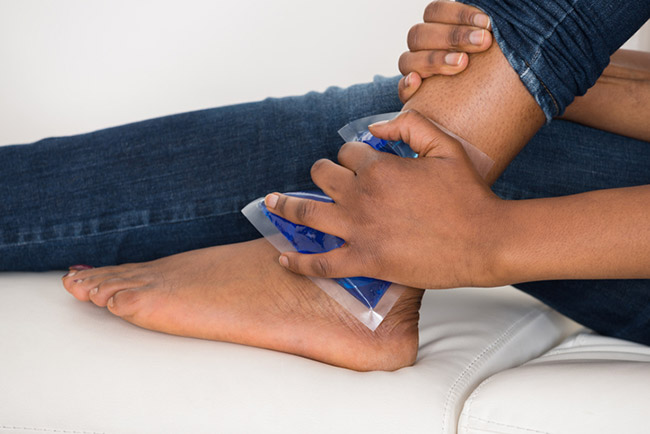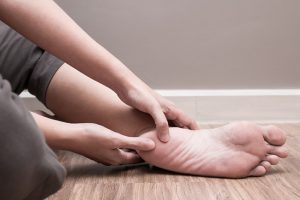
1. THE ANKLE IS COMPOSED OF JUST THREE MAIN BONES.
The true ankle joint is composed of three bones: the tibia, or the inside part of the ankle; the fibula, the outside part of the ankle, and the talus, underneath. These allow the flexion and extension of the foot, letting you make the up and down motions that you require to walk. Below the ankle joint is actually a second joint called the subtalar joint, which allows side-to-side motion of the foot. Altogether, the human foot and ankle contain 26 bones, 33 joints, and more than 100 muscles, tendons, and ligaments.
2. THE ANKLE JOINT IS NOTORIOUSLY WOBBLY.
Despite how often humans are on their feet, the ankle joint is small and unstable in the best of times because of its precarious anatomical structure. Most people will experience a tweaked, twisted or sprained ankle at least once in their lives.
3. ANKLE SPRAINS ARE THE MOST COMMON INJURY IN AMERICA.
When you couple the weak ankle joint with the vigorous activity it’s required to perform, it’s no surprise that ankle sprains account for nearly 2 million injuries every year, or 20 percent of all sports injuries in the United States.
4. NOT ALL OF THESE SPRAINS ARE SPORTS-RELATED.
Researchers from the University of Alabama at Birmingham reported an estimated 125,355 high heel-related injuries in U.S. Emergency Departments between 2002 and 2012. In 2011 alone, there were a reported 19,000 injuries from high heels. The injury rate was greatest for women in their 20s. Another survey from the College of Podiatry found that most women reported foot pain after one hour and six minutes of wearing high heels, and 20 percent of participants said that they felt pain after just 10 minutes of wear.
Foot and Ankle Pain
When your feet hurt, your whole body hurts. And no wonder: Your feet have to support your entire body’s weight. There is no other part of your body that is put under such constant pressure, whether you are walking, running or jumping. And many times our feet are rewarded by being crammed into ill-fitting shoes with little or no support.
Unfortunately, once you have foot pain, it is difficult to relieve the pain by staying off your feet completely. What’s worse, foot and ankle pain often worsens over time. This means that the longer you try to cope with the pain, the more damage you may be causing.
Plantar Fasciitis
 This condition is a common cause of heel and foot pain. “Plantar” means the bottom of the foot, “fascia” is a type of connective tissue and “itis” means inflammation. The American Orthopedic Foot and Ankle Society defines plantar fasciitis as an “overuse injury” resulting from the inflammation of a band of tissue in the sole of the foot that links the heel bone to the toes. It has been reported that plantar fasciitis occurs in 2 million Americans a year and 10 percent of the population over a lifetime.
This condition is a common cause of heel and foot pain. “Plantar” means the bottom of the foot, “fascia” is a type of connective tissue and “itis” means inflammation. The American Orthopedic Foot and Ankle Society defines plantar fasciitis as an “overuse injury” resulting from the inflammation of a band of tissue in the sole of the foot that links the heel bone to the toes. It has been reported that plantar fasciitis occurs in 2 million Americans a year and 10 percent of the population over a lifetime.
The classic symptoms of plantar fasciitis include heel pain that is usually most severe early in the morning. The plantar fascia is one of the longest and strongest ligaments in your entire body. It runs along the bottom of your foot and supports your arch.
Risk factors include:
- Your feet roll inward too much when you walk (excessive pronation).
- You have high arches or flat feet.
- You walk, stand or run for long periods of time, especially on hard surfaces.
- You are overweight.
- You wear shoes that don’t fit well or are worn out.
- You have tight Achilles tendons or calf muscles.
- Problems somewhere else in the kinetic chain (e.g. knee or hip).
Ankle Pain
Ankle Pain can be the result of a strain, sprain, tendinitis or arthritis. Ankle sprains and strains are among the most common musculoskeletal injuries. They can occur on both sides of the joint, and are typically caused by the sudden stretching or twisting of the ankle joint. There may be pain, swelling or even a tear. If your doctor has ruled out a fracture, physical therapy can help reduce the pain and swelling and speed up recovery times.
Other Foot and Ankle Injuries
Tendonitis can result from an overuse injury or running. This typically causes inflammation, pain and tenderness. Osteoarthritis can also occur in the heel joint, resulting in inflammation, stiffness and pain caused by bone on bone contact.
Physical Therapy for Foot and Ankle Pain
Physical therapy is considered one of the most effective methods for treating foot and ankle pain. Many times pain in the lower extremities is a result of a dysfunction in another part of the kinetic chain, such as lower back or hip. Your physical therapist will not only help treat the condition with which you are experiencing symptoms, but also the underlying causes.
Physical therapy is an effective form of pain management, and this form of treatment usually does not rely on pain medications. So the work you do with your physical therapist can actually help you recover from an injury, rather than simply find a way to mask the pain.
When you’re ready to get started with one of our experts at Novant Health Physical Therapy, call us toll-free at (877) 342-2669 or register online for a consultation. We can help you with a treatment plan for your foot and ankle pain.


